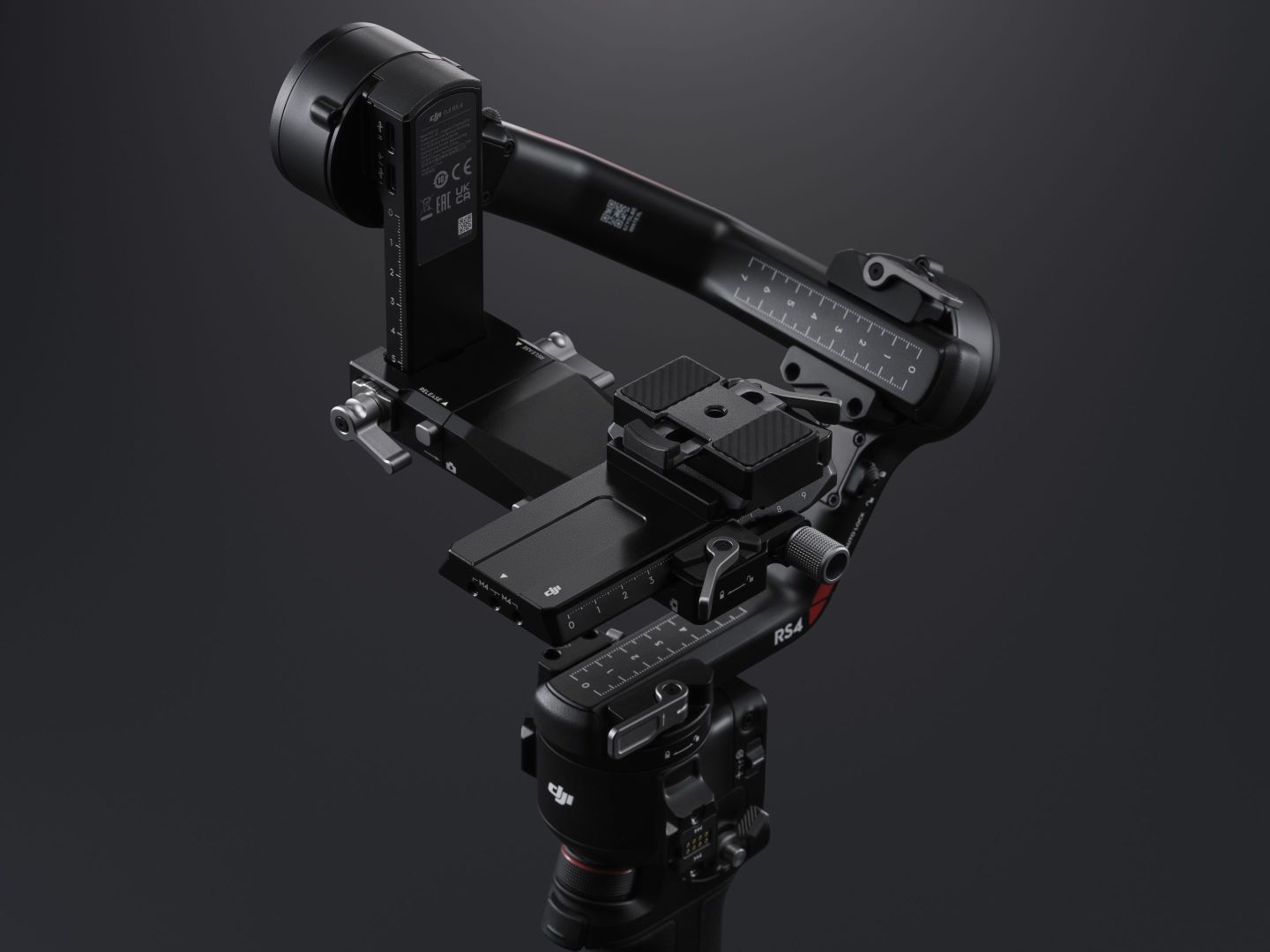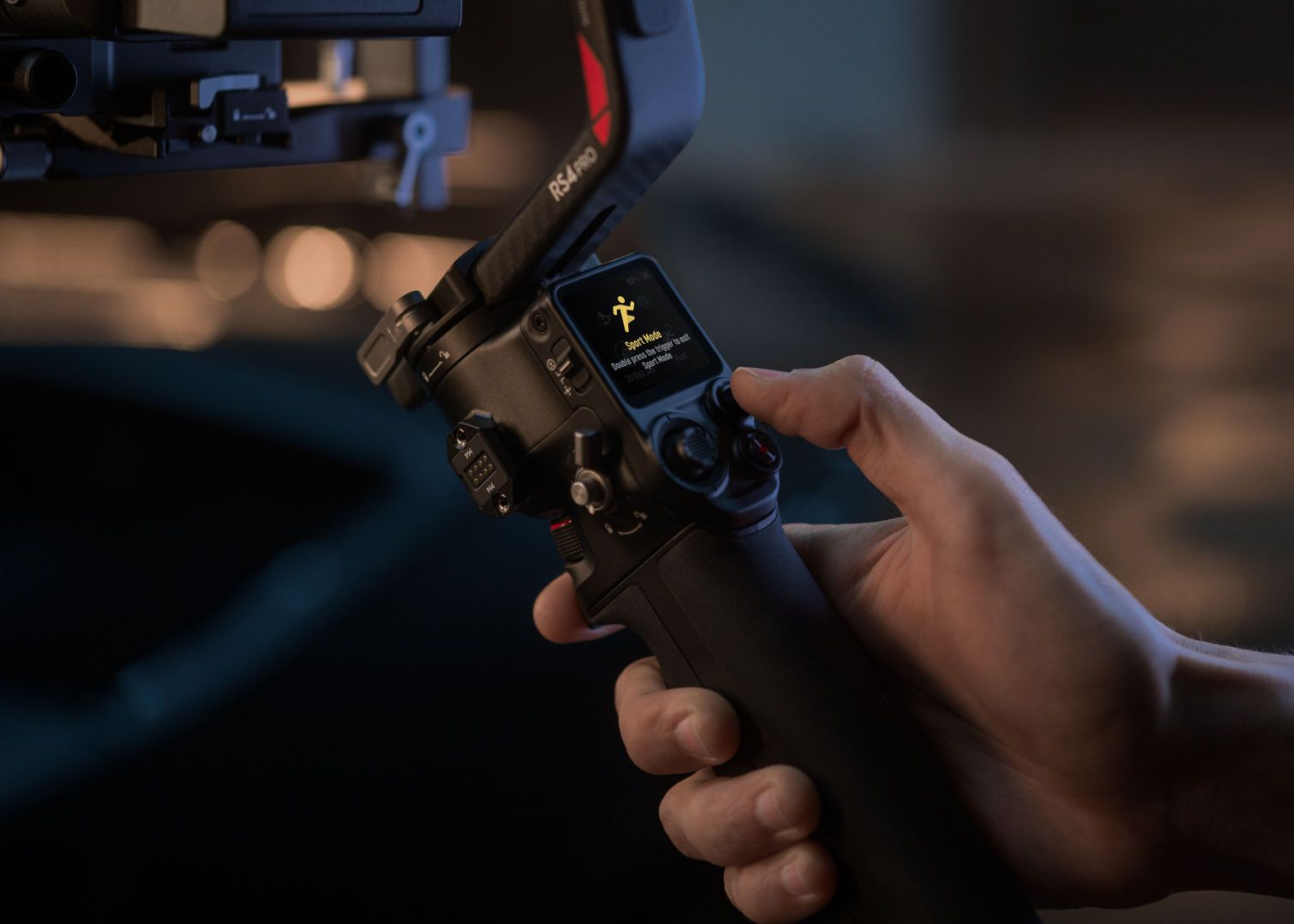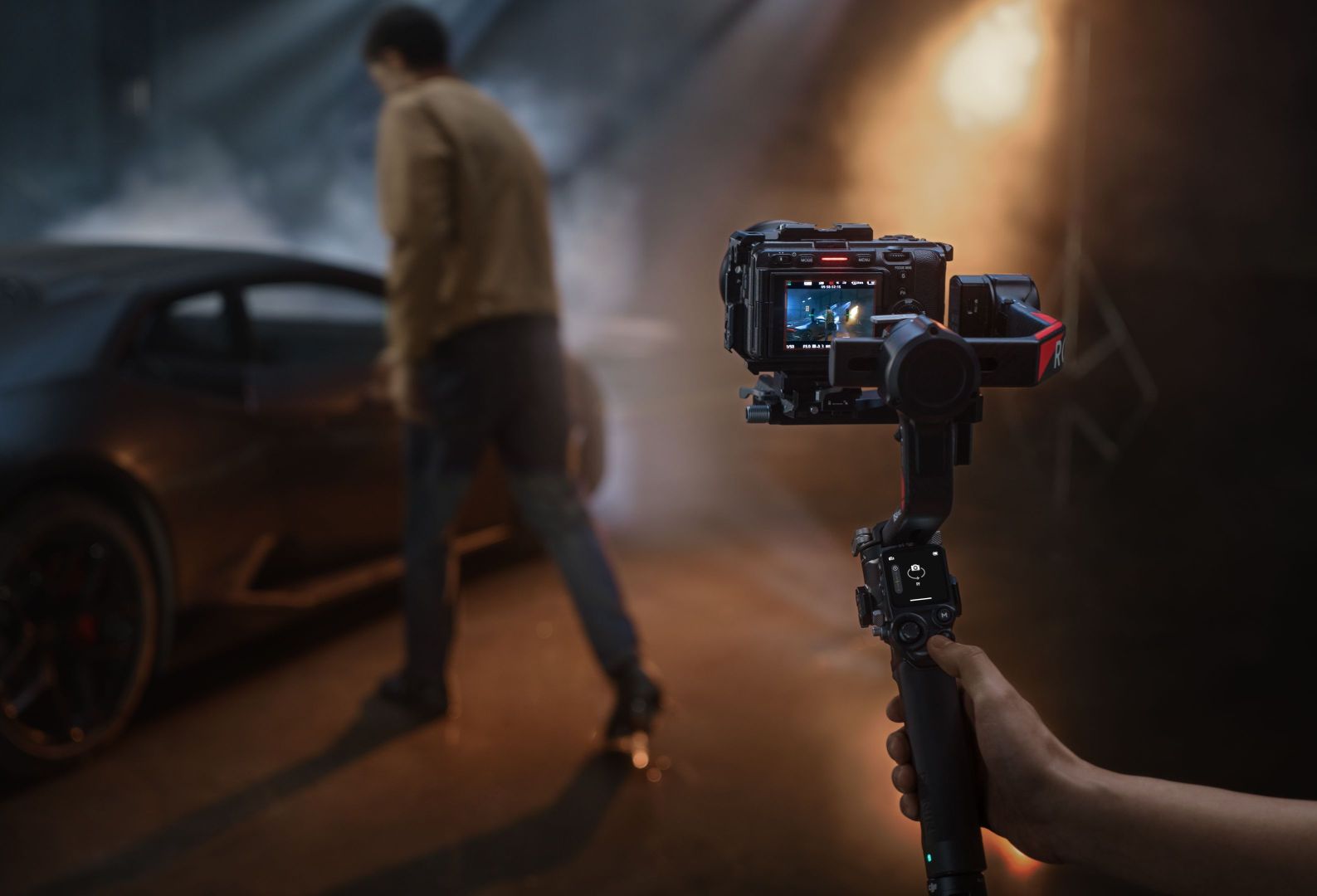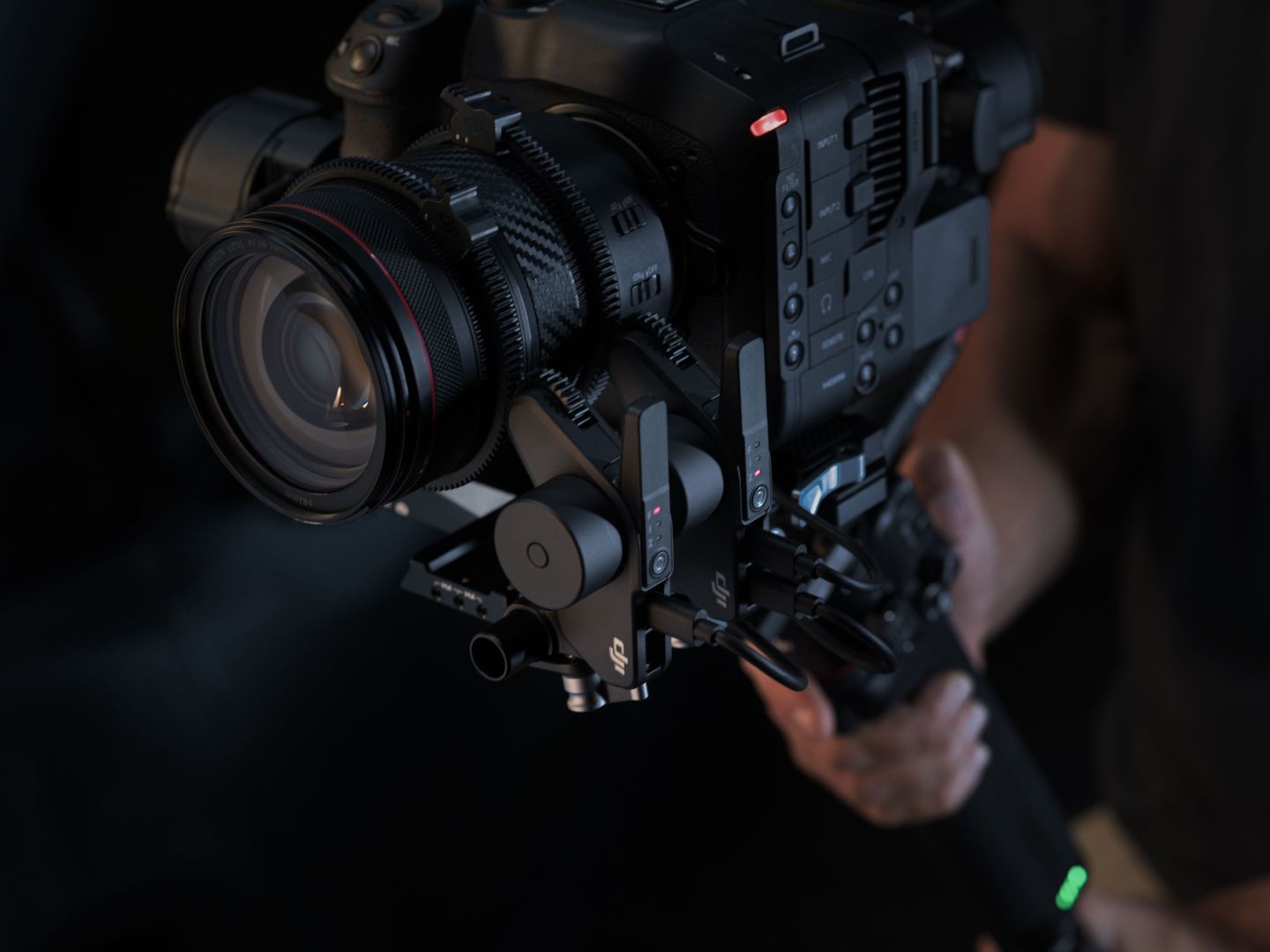DJI RS 4
The DJI RS 4 is a lightweight, commercially available stabilizer that supports next-generation, native vertical shooting, as well as greater operational efficiency, improved stabilization performance and an enhanced accessory ecosystem. It provides solo cinematographers with an even more professional and effective creative experience and the tools they need for immersive visual storytelling.

Quick setup
2. Generation native vertical recording
Designed with an all-new horizontal plate, the RS 4 Pro now offers second-generation native vertical shooting for faster and easier operation. For efficient vertical video shooting, the cameraman can simply release the horizontal plate without the need for a separate tool and lock it in the vertical position, allowing easy conversion to vertical shooting. [2]
2. Generation automatic axle locks
The RS 4 can quickly enter standby or sleep mode thanks to the automatic shafts locks, significantly improving recording, mode switching and storage efficiency. In addition, the axle locks operate with even less backlash when locked, further reducing gimbal shake during recording.
The smoothest balancing experience ever
All three shafts of the DJI RS 4 are Teflon™ coated for less friction and smoother balancing. When swapping cameras or lenses, use the fine adjustment knob on the tilt axis to move the camera forward or backward for precise balancing to the nearest millimetre. An adjustable positioning baffle is included on the top quick-release plate to hold the camera securely.
Automatic screen lock
The OLED touchscreen features a new automatic screen lock function. When the screen is locked, the current gimbal and stick control modes are displayed at low brightness. This not only prevents accidental touches, but also saves battery power.

Powerful stabilization
Excellent load capacity
The lightweight body boasts a load capacity of 3 kg. Capable of carrying the most common mirrorless camera and lens combinations, it can comfortably carry the necessary load while offering robust performance. Compared to the previous generation, the RS 4's tilt axis is 8.5 mm longer, offering even greater balancing space. This allows for the fitting of more common mirrorless camera and lens combinations, as well as other accessories such as ND filters, giving an even wider range of creative possibilities.
4. Generation RS stabilisation algorithm
The next generation RS stabilisation algorithm is optimised in all aspects for different applications. It strikes a balance between stabilisation strength and the tactile feel of camera movement, delivering superior stabilisation performance and an enhanced user experience. In addition, the RS 4 provides significantly greater stability when shooting vertical shots, making it easy to stabilize dynamic shots such as running or low-angle perspectives.
Professional creation

A DJI RS 4 támogatja a DJI PRO termékek professzionális szintű funkcióit, ezáltal kiváló teljesítményt nyújt, így az egyszemélyes filmezést is hatékonyabbá teszi.
Bluetooth wireless control
Thanks to Dual-Mode Bluetooth technology, the DJI RS 4 can remotely control the camera shutter button and lens zoom. In zoom control mode, the operator can also use the joystick to control the Power Zoom and Clear Image Zoom [3] functions designed for PZ lenses. The camera only needs to be paired once, after which it will automatically reconnect seamlessly.
DJI Focus Pro engine support
When paired with the new DJI Focus Pro motor, [4] the DJI RS 4 allows you to control the focus of the lens with the control ring or adjust the zoom of the lens with the stick control. This seamless operation allows for efficient lens control.
Customise the function of the release button
The release button can also be set to trigger FPV mode, where holding the release button down will cause all three axes of the gimbal to follow the direction of movement of the Grip handle. This is particularly useful for shooting rotating footage or for viewpoint simulations.
Gimbal mode switch
The mode switch allows you to instantly switch between PF, PTF and FPV modes. For precision use of the RS 4 and to suit your specific shooting needs, you can set 3D Roll 360 mode or Custom mode instead of FPV mode.

The whole ecosystem of accessories
RSA communication port
The DJI RS 4 is the first to include an RSA communication port, which allows the connection of accessories such as the DJI RS Tethered Control Handle, [6] and other accessories from external developers, such as control handles [6] or remote control ring handles. [6] Flexibility to switch between different shooting settings to suit creative needs. Thanks to the DJI RS SDK protocol, third-party manufacturers and custom developers can develop custom features for the RS 4 to meet a wider range of shooting needs.
DJI RS BG70 high capacity battery grip
The new BG70 High Capacity Battery Grip [6] can extend the battery life of the RS 4 to 29.5 hours. [7] It supports powering cameras and accessories up to 18W via the USB-C port on the bottom.
Support for DJI Ronin Image Transmitter
For both independent filmmakers and smaller crews, the Ronin Image Transmitter [6] provides live HD image transfer, remote gimbal and camera control, ActiveTrack 4.0, Force Mobile and a host of other features, giving you an integrated shooting experience with control and monitor functions.
Sidenote
* The DJI RS 4 requires the DJI Ronin app to be activated the first time you use it.
- The measurement was made by comparing the battery life of the DJI RS 4 with the DJI RS BG70 high capacity battery grip and the DJI RS 4 with the DJI RS BG21 battery grip. Battery life was measured in a 25°C indoor environment with the gimbal in a balanced, horizontal, resting position until the battery charge reached 3% (with the battery grip feeding only the gimbal).
- The gimbal should be rebalanced after switching between horizontal and vertical shooting.
- Details of compatible cameras and lenses can be found on the Ronin series compatibility search page.
- The DJI RS 4 Combo product bundle includes a DJI Focus Pro motor. For the standalone version, the motor must be purchased separately.
- Compared to the DJI RS Focus Motor (2022).
- Sold separately.
- Measurements were taken in a 25°C indoor environment with the gimbal in a balanced, horizontal, resting position until the battery charge reached 3% (with the battery grip feeding only the gimbal).
- The measurement was performed in an indoor environment at 25 °C.
Specs
- Accessory ports: Ronin series accessories (RSA)/NATO ports, 1/4"-20 mounting hole, flash shoe connector, Video transfer port (USB-C), RSS camera control port (USB-C), Focus motor port (USB-C)
- Battery: BHX711-3000-7.2V
- Battery type: LiPo 2S
- Battery Capacity: 3000 mAh
- Power: 21 Wh
- Maximum battery life: 12 hours (The gimbal is measured to be balanced, level and stationary. When the gimbal is in motion, the operating time is reduced).
- Charging time: Approx. 2.5 hours (measured with a charger supporting 18 W fast charging. Recommended to use chargers supporting PD protocol).
- Bluetooth: 5.1
- Ronin App Requirements: iOS 11.0 or later, Android 8.0 or later
- Languages supported by the touchscreen: English, Simplified Chinese, Traditional Chinese, German, French, Korean, Japanese, Spanish, Portuguese (Brazil), Russian, Thai
- Tested load capacity: 3 kg
- Operating frequency: 2.400-2.4835 GHz
- Weight: Gimbal: 1066 g, Handle: 203 g, Extended handle/stand (plastic): approx. 183 g, Top and bottom quick release plates: approx. 98 g
In The Box
Gimbal
BG21 battery grip
Quick release plate (Arca-Swiss/Manfrotto)
Extended grip/stand (plastic)
Lens mounting support
Multi-camera control cable (USB-C, 30 cm)
USB-C charging cable (40 cm)
DJI logo sticker
Screw kit































